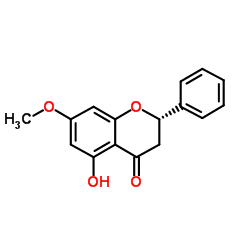Efficient microwave-assisted prenylation of pinostrobin and biological evaluation of its derivatives as antitumor agents.
Hadi Poerwono, Shigeru Sasaki, Yoshiyuki Hattori, Kimio Higashiyama
Index: Bioorg. Med. Chem. Lett. 20 , 2086-9, (2010)
Full Text: HTML
Abstract
Pinostrobin (5-hydroxy-7-methoxyflavanone) obtained in relatively large amounts from fingerroot (Boesenbergia pandurata) was converted to its C-6 and C-8 prenylated derivatives. The Mitsunobu reaction, europium(III)-catalyzed Claisen-Cope rearrangement, and Claisen reaction coupled with cross-metathesis were used as the key steps. Using a sealed-vessel microwave reactor, the Mitsunobu and Claisen/Cope reactions occurred smoothly with short reaction times and in satisfactory yields. The target compounds and five new intermediary substances showed cytotoxic activity toward SK-BR-3, MCF-7, PC-3, and Colo-320DM human tumor cell lines, and all of them had significantly lower IC(50) (microM) values than pinostrobin.Crown Copyright 2010. Published by Elsevier Ltd. All rights reserved.
Related Compounds
| Structure | Name/CAS No. | Molecular Formula | Articles |
|---|---|---|---|
 |
Pinocembrin-7-methyl ether
CAS:480-37-5 |
C16H14O4 |
|
Phloroglucinols from anti-microbial deposit-resins of Austra...
2015-01-01 [Phytother Res. 29(1) , 48-58, (2015)] |
|
Study on the constituents of Mexican propolis and their cyto...
2010-04-23 [J. Nat. Prod. 73 , 623-7, (2010)] |
|
Cytotoxic flavonoids from the leaves of Cryptocarya chinensi...
2010-09-24 [J. Nat. Prod. 73 , 1470-5, (2010)] |
|
Structure-activity relationships of flavonoids as inhibitors...
2011-03-15 [Bioorg. Med. Chem. 19 , 2090-102, (2011)] |
|
Antimalarials from nature.
2009-05-01 [Bioorg. Med. Chem. 17 , 3229-56, (2009)] |